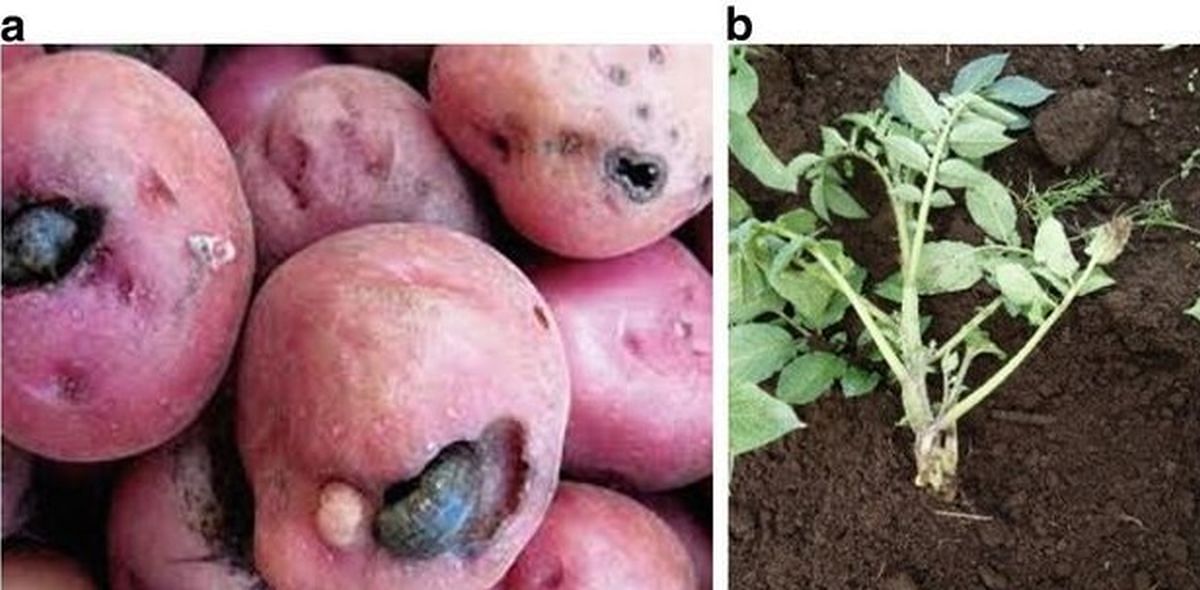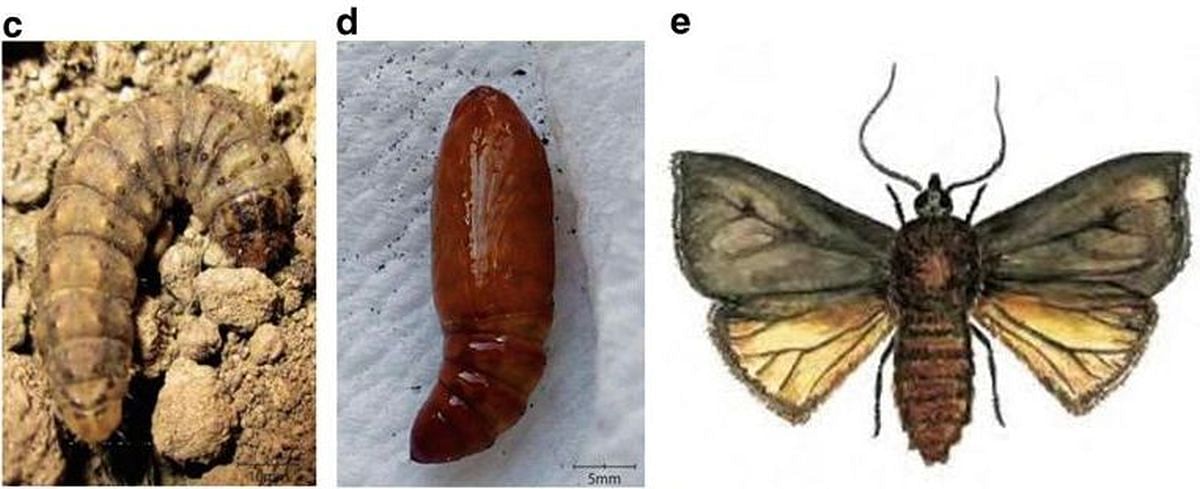Scientific description of the Cutworms (2020)
Based on J. Kroschel. et al. (2020) Insect Pests Affecting Potatoes in Tropical, Subtropical, and Temperate Regions. In: Campos H., Ortiz O. (eds) The Potato Crop. Springer, Cham
The authors of this content are Jürgen Kroschel, Norma Mujica, Joshua Okonya, Andrei Alyokhin
Agrotis ipsilon (Hufnagel, 1776), Peridroma saucia (Hübner, 1808),
Agrotis segetum (Denis & Schiffermüller, 1775) (Lepidoptera: Noctuidae)
Distribution
Cutworms are larvae of several noctuid moth species which are cosmopolitan (images below). Most widely distributed are the black cutworm (Agrotis ipsilon), the variegated cutworm (Peridroma saucia) and the turnip moth (Agrotis segetum). Their origin is uncertain but specimens which were used to describe A. ipsilon in 1766 were collected from Austria.

Cutworm larval damage on potato tuber (a), and freshly cut potato plant (b). (Courtesy: CIP)

Cutworm larva (c), pupa (d) and adult (e) of Agrotis ipsylon. (Courtesy: CIP)
Host range
Cutworms are polyphagous and have been reported as a pest on nearly all vegetable crops and some cereals. It’s a pest in potato, maize, alfalfa, clover (Trifolium L.), cotton, rice, sorghum, strawberry, sugar beet, and tobacco. The larvae sometimes prefer to feed on weeds such as bluegrass (Poa pratensis L.), curled dock (Rumex crispus L.), lambsquarters (Chenopodium album L.), yellow rocket (Barbarea vulgaris W.T. Aiton); and redroot pigweed (Amaranthus retroflexus L.).
Considerable damage has also been observed among shrubs and trees such as linden (Tilia sp.), wild plum (Prunus sp.), crabapple (Malus sp.), and lilac (Syringa vulgaris L.). Cereals such as oats (Avena sativa L.), barley (Hordeum vulgare L.), sorghum, maize, and wheat (Triticum spp.) are also affected.
Symptoms of infestation
The cutworm larvae remain in the soil at the base of the plant during the day. At night, some species cut down the stems of young potato plants, while other species climb the plants and feed on their leaves. Old instar larvae can occasionally tunnel into potato stems disrupting plant growth.
Tubers closer to the ground surface may suffer occasional damage. In a single night, as single larva can cut down several potato plants.
Impacts on production losses
Cutworms if not detected early and during outbreaks can cause up to 100% crop loss through cutting down of potato plants.
Methods of prevention and control
- Monitoring.
Use of sex pheromones in white and yellow traps during spring are quite effective in predicting attacks. Baited traps can also be used to monitor larva populations in the field (Sanchez and Vergara 2002). - Cultural control.
Deep tillage exposes larvae and pupae to the action of natural enemies and may crash them mechanically. Weed control also aids in reducing cutworm damage by reducing the sites for egg-laying because these insects infest a wide range of host plants. Properly covering tubers during hilling impedes larval access to the tubers.
Late harvest results in a greater damage of tubers. Hand picking of the larvae very early in the morning is the most commonly used method for cutworm control among smallholder farmers in Africa. Fallowing and crop rotation with none host plants such as bluegrass, onion, garlic, peppermint (Mentha piperita L.) and coriander can also reduce cutworm populations as well as habitat management and farming practices that conserve populations of existing natural enemies.
Trap cropping using susceptible host plants such a sunflower or cosmos (Cosmos sp.) has also been used in combination with daily killing the trapped cutworm larvae.
Flooding of the infested field between crops can also kill the cutworm larvae. Sticky substances such as mollasses and saw dust can also be spread at the base of the plant to trap the cutworm larvae. - Transgenic plants.
Several transgenic crops (maize, tobacco, wheat, cotton and maize) have been reported to be resistant to cutworm damage. The genes responsible for resistance against A. ipsilon include Bacillus thuringiensis cry1Ac gene (Bt), barley trysin inhibitor (Bti-cme) and cowpea trypsin inhibitor (CpTi).
Preliminary results of genetically modified potatoes show that feeding larvae on leaves which expresses Cry3Aa affect larvae by being toxic, and also that Bt potatoes curb the growth and reproduction of the adults of Agrotis ipsilon. - Biological control.
Cutworms are hosts for numerous parasitoid wasps and flies, including species of Braconidae Cotesia ruficrus (Haliday), Snellenius manilae (Ashmead), Ichneumonidae Tenichneumon panzer (Wesmael), Tachinidae Bonnetia comta (Fallen), Euplectrus plathypenae and Eulophidae, with rates of parasitism as high as 75–80%.
Up to 60% of cutworm larvae have been reported to be killed by an entomopathogenic nematode, Hexamermis arvalis in central USA. Entomopathogenic nematodes that have been used in the control of A. ipslon larvae include Steinernema glaseri, S. riobrave and Steinernema carpocapsae (Sanchez and Vergara 2002). - Biopesticides.
Extracts from the following plants have demonstrated to be toxic to the larvae of A. ipslon: Nerium oleander L. leaves, neem leaves and seeds, Melia azedarach L. fruits, Bassia muricate (L.) Asch., Lantana sp., Parthenium sp., Hyptis sp., Ipomoea carnea Jacq., Tephrosia nubica (Boiss.) Baker, Bidens pilosa L. and Rumex nepalensis Spreng. roots (CABI 2018a). - Chemical control.
Spotted or localized field infestations by cutworms are typical, calling for focused subsurface soil insecticide applications. The use of toxic baits is recommended because of its specificity against these insects and because it does not markedly affect the biological control agents. Toxic baits prepared as a mix of bran, molasses, water, and insecticide should be applied at the base of plants at dusk (CIP 1996; Larrain et al. 2003).
